Lightfoot Travel
WhatsApp Business Account
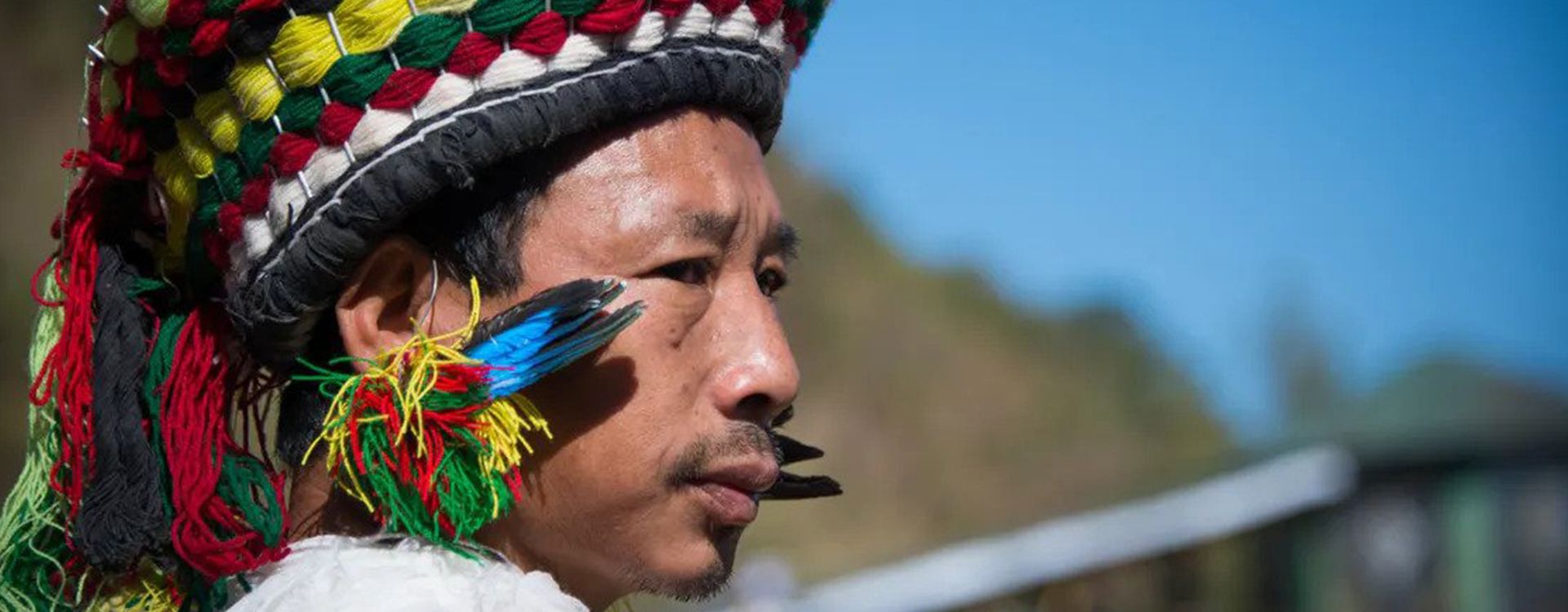
“Nagaland, what is that? Some kind of theme park?” said people when they quizzed me about my next trip. No, it’s not a theme park – though there’s enough colour, excitement and liveliness to be found that you might be forgiven for likening it to Disneyland in parts. It is, in fact, one of the more north-easterly of India’s states that borders Myanmar and hosts the annual Hornbill Festival– a cultural extravaganza – at the village of Kisama on the edge of the state capital, Kohima. Until recently, Nagaland was cut off from the rest of the world due to political unrest. Now it is welcoming visitors with open arms into its picturesque land.
I met my guide Chander in neighbouringAssam, so I’d witnessed the change in landscape from lush rice paddies and tea plantations that surrounded the Brahmaputra river basin to harsher mountain scenery as the border loomed. Once inside Nagaland, we were soon careering around hairpin bends and overlooking vast forested valleys with precariously perched mountain-side houses. My ears popped as we headed ever upwards and it became abundantly clear as to why this region had been so cut off from the rest of the country and why its culture was so markedly different.
We reached Kisama as the late afternoon shadows were lengthening and encroaching on the mountain vistas. My first glimpse of one of the dynamic festivals in Asia was quite a fitting vignette – a western-looking couple in tie-dye chatting to a man in full tribal garb brandishing a seven-foot long spear.
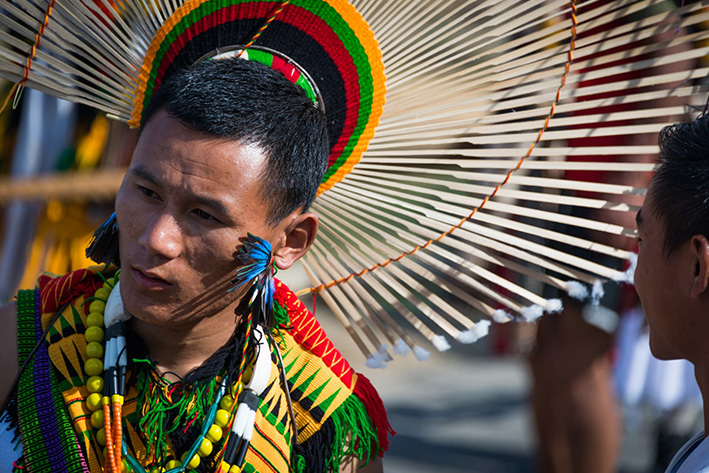
The heritage village of Kisama consists of a hillside peppered with thatched morungs (meeting houses) that are centered around a showground. We were swiftly welcomed into the Konyak tribe morung by women decked in layers of patterned, woven cloth and garlanded with many strands of tiny, brightly-coloured beads. I commented on the beautiful earrings they wore and one replied that they’re made from the downy feathers of the famed bird that gives the Hornbill Festival its name. It wasn’t long before a carved bamboo mug brimming with rice beer was thrust into my hand and I was offered a plate of fatty, aromatic smoked pork. Before I knew it I was jerkily jigging along with them to the local pop music coming from the tinny radio.
We stayed overnight in a family home on the outskirts of Kohima. It was a modern, plain yet spacious apartment and a contrast from what we’d experienced earlier. The open fire in the corner was also a welcome respite from the dramatically dropping temperature outside. There was a hearty spread of locally grown red rice, and an array of gently boiled cauliflower and beans simply seasoned with ginger and garlic. The notoriously hot Naga chilli chutney was an optional extra.
Upon returning to the heritage village the following morning, we found the air filled with the smell of wood-burning fires and the discordant sounds of flutes, whistles and chants merging and melding to different drum beats as we wandered among the morungs. Each tribe gradually began to take its place around the showground and many joined hands and bobbed up and down to whichever beat was most audible as the incongruously suited dignitaries and more leisurely clad, camera-toting tourists weaved about them. The official opening ceremony gave way to the start of the Cultural Show.
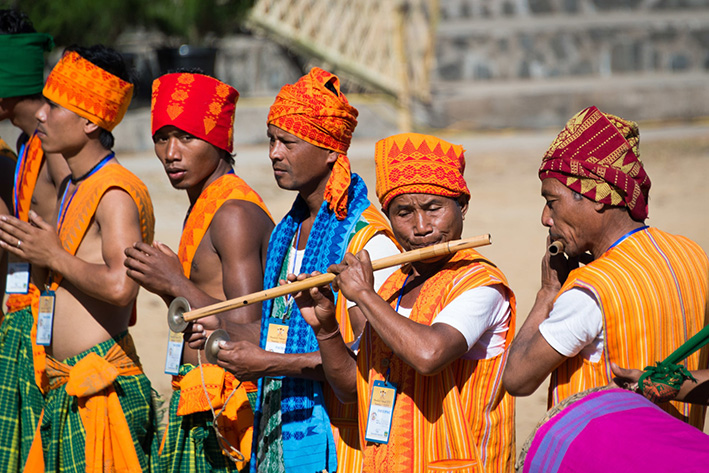
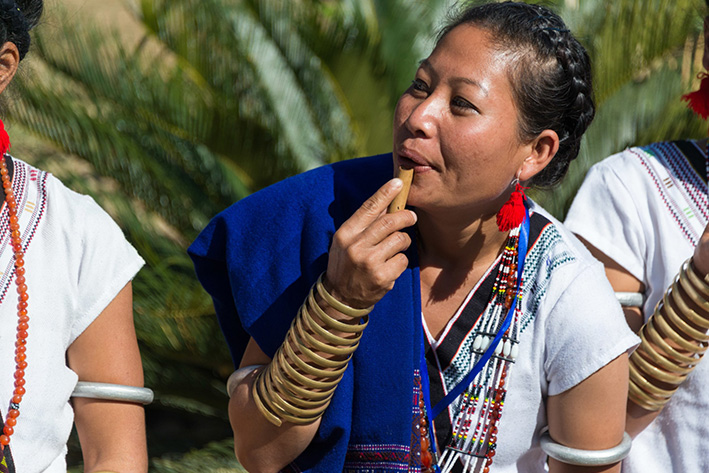
We were first treated to a Hornbill dance – in which the flight of the bird is mimicked – by the Ao tribe, followed by a dance to the gods to thank them for a good harvest from the Garo tribe and a dance for times of scarcity from the Angami tribe, all of which consisted of mesmeric vocal repetitions and variously choreographed stepping movements either in a rough circle or in lines. Then the Khiamniungan tribe took to the floor with their spears and gigantic shields and replicated what might have been enacted en route to war. This was followed by some light relief from the Kachari tribe reenacting a marriage proposal which was much like watching a soap opera in a foreign language. My favourite, however, was the stone-throwing competition from the Chakhesang tribe – a simple game whereby a stone is thrown at an upright stick in the ground.
For lunch we sampled entries in the inaugural Naga Masterchef competition – chicken steamed with those extremely hot naga chillies – and then returned to the main stage to discover impenetrable crowds cheering and shouting encouragement in the Greased Bamboo Pole climbing competition. We managed to scramble towards the front to see four lithe young men, the sinews of their muscles straining as they as inched higher and higher up tall bamboo poles before, inevitably slipping back down again.
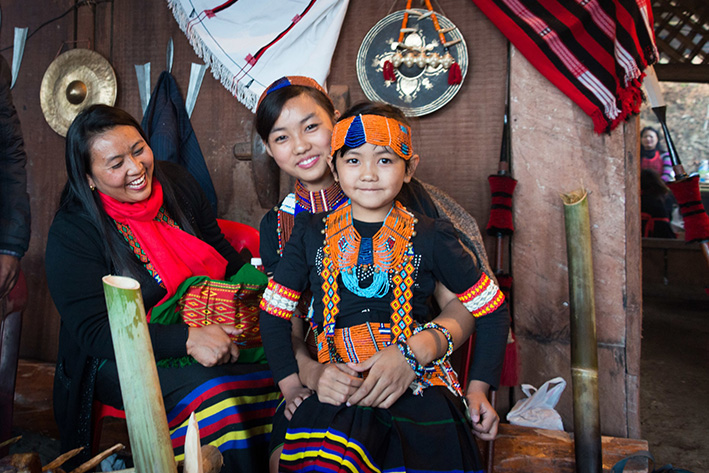
Kohima sealed its place in world history as the most easterly frontier during WWII and it was where the Allied troops fought against the Japanese with only a tennis court between them. We took a brief moment away from the festivities to pay our respects at the expansive war cemetery where I was rather moved reading all the incredibly British sounding names from all over the UK alongside their Indian comrades.
In a final stop off in the region, we drove along roads flanked in the sub-tropical forest to a rather remote patch overlooking a vast valley. Here we came face to face with a pair of stoic looking tribal elders, spears in hand, with scores of women and children, lined up behind each one to witness a once-in-seven-years stone pulling ceremony. There must have been tens of thousands of ‘villagers’ walking in front of this stone and the anticipation grew as the chain morphed from the women and children idly chatting as they walked, to the men of the tribe, each adorned with impressive headdresses of wood and hornbill feathers, firstly chanting in simple chords and, as the stone grew closer, chorusing something akin to ‘heave’. The stone was tied with malleable branches on sturdy wooden support and surrounded by more than a hundred men of all ages straining their muscles in the face of the hairpins and gradients of the road ahead. Truly one of the most incredible spectacles I’ve ever witnessed, it was topped off by the ensuing celebratory feast of dried hornets, wood grubs and crab back in the village.
No, it’s not a theme park, but certainly a feast for the senses.
Tel Aviv & JaffaJerusalemGalilee
